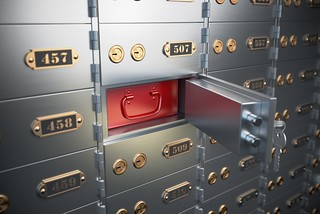
PREV ARTICLE
NEXT ARTICLE
FULL ISSUE
PREV FULL ISSUE
V25 2022 INDEX E-SYLUM ARCHIVE HISTORY OF THE SAFE DEPOSIT BOXMeanwhile, the folks at The Hustle dive into the economics of the safe deposit box business, the place where so many coin collections reside. -Editor
In Hollywood, safe deposit boxes are so prominent, in fact, that it's easy to miss the seismic changes racking the industry: In the wake of the 2008 financial crisis, big banks have quietly abandoned the safe-deposit business. Both HSBC and Barclays have shuttered their safe-deposit services in many countries, and Capital One joined them in 2016. Most recently, this past September, JPMorgan Chase announced it was phasing out its safe deposit boxes, too. In the coming decade, other major banks seem likely to join them.
The rise of the safe deposit box In March 1861, while on a trip to England, Jenks — the moneyed son of a Harvard professor — began to wonder what he was supposed to do with his valuables while he was out of town.
He decided to create a company that would store items for New York's Rather than worry about burglaries, Jenks suggested that the urban elite store their books, wills, jewelry, tea sets, and silver with him. He opened a massive, marble building in lower Manhattan, complete with a thick steel vault. Inside, he offered 500 safe deposit boxes to customers. To ensure the safety of the boxes, Jenks required two keys to unlock a box: one key for the customer and one key for his employees. Guards armed with muskets stood in front of the building at 146 Broadway through the night. He called it the Safe Deposit Company of New York. It was the first company of its kind — and as the Civil War broke out, demand soared. Bold-faced names like the Vanderbilts, the Guggenheims, the Roosevelts, and more began storing their valuables with Jenks. Hetty Green, the millionaire businesswoman, maintained a private vault so big that it could fit a desk inside of it. It was such a success that copycat safe deposit box companies began proliferating across the US, with names like the Mercantile Safe Deposit Company and the Lincoln Safe Deposit Company. While the first safe-deposit companies were stand-alone organizations, dedicated solely to safekeeping, major banks soon got involved. By the early 20th century, nearly every bank in America had a safe-deposit arm.
To read the complete article, see:
Wayne Homren, Editor The Numismatic Bibliomania Society is a non-profit organization promoting numismatic literature. See our web site at coinbooks.org. To submit items for publication in The E-Sylum, write to the Editor at this address: whomren@gmail.com To subscribe go to: https://my.binhost.com/lists/listinfo/esylum All Rights Reserved. NBS Home Page Contact the NBS webmaster 
|

